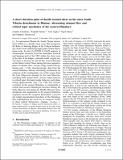Files in this item
A short-duration pulse of ductile normal shear on the outer South Tibetan detachment in Bhutan : Alternating channel flow and critical taper mechanics of the eastern Himalaya
Item metadata
| dc.contributor.author | Chambers, Jennifer | |
| dc.contributor.author | Parrish, Randall | |
| dc.contributor.author | Argles, Tom | |
| dc.contributor.author | Harris, Nigel | |
| dc.contributor.author | Horstwood, Matthew | |
| dc.date.accessioned | 2011-09-10T23:05:01Z | |
| dc.date.available | 2011-09-10T23:05:01Z | |
| dc.date.issued | 2011-03-11 | |
| dc.identifier | 7047018 | |
| dc.identifier | 14ec337a-c208-45d7-a6f9-5f4862b4ce1a | |
| dc.identifier | 000288334200001 | |
| dc.identifier | 79952757056 | |
| dc.identifier.citation | Chambers , J , Parrish , R , Argles , T , Harris , N & Horstwood , M 2011 , ' A short-duration pulse of ductile normal shear on the outer South Tibetan detachment in Bhutan : Alternating channel flow and critical taper mechanics of the eastern Himalaya ' , Tectonics , vol. 30 , pp. TC2005 . https://doi.org/10.1029/2010TC002784 | en |
| dc.identifier.issn | 0278-7407 | |
| dc.identifier.uri | https://hdl.handle.net/10023/2002 | |
| dc.description | Field work was supported by a NERC Research Studentship field grant. | en |
| dc.description.abstract | In easternmost Bhutan the South Tibetan detachment (STD) is a ductile shear zone that juxtaposes the Radi (or Sakteng) klippe of the Tethyan Sedimentary Series from underlying high-grade Greater Himalayan rocks. In situ LA-ICPMS U-Th-Pb analysis of metamorphic monazite from the immediate footwall and hanging wall of the STD within the shear zone at the base of the klippe, constrains north vergent normal shear to between 25 and 20 Ma. Coeval thrusting on the Main Central Thrust during this time supports a phase of channel flow-viscous wedge model activity, lasting only similar to 3 Ma. Geochronologic data from the eastern Himalaya indicate alternating mechanisms for extrusion of the metamorphic core of the orogen from the Late Oligocene through to the Late Miocene, switching from channel flow-viscous wedge behavior to critical taper-frictional wedge behavior, each phase lasting approximately only 2 to 5 Ma. The tectonic evolution of the eastern Himalaya is comparable to central and western Himalayan tectonics during the Early Miocene, but during the Middle Miocene metamorphism and magmatism in the eastern Himalaya migrated toward the orogenic hinterland, a process not widely documented elsewhere in the Himalaya, thus highlighting the need for an orogenic model in three spatial dimensions. Citation: Chambers, J., R. Parrish, T. Argles, N. Harris, and M. Horstwood (2011), A short-duration pulse of ductile normal shear on the outer South Tibetan detachment in Bhutan: Alternating channel flow and critical taper mechanics of the eastern Himalaya, Tectonics, 30, TC2005, doi:10.1029/2010TC002784. | |
| dc.format.extent | 12 | |
| dc.format.extent | 7470260 | |
| dc.language.iso | eng | |
| dc.relation.ispartof | Tectonics | en |
| dc.subject | Prograde metamorphic reactions | en |
| dc.subject | Main central thrust | en |
| dc.subject | MC-ICP-MS | en |
| dc.subject | U-PB | en |
| dc.subject | Continental collision | en |
| dc.subject | Lesser himalaya | en |
| dc.subject | Monazite | en |
| dc.subject | Evolution | en |
| dc.subject | Sequence | en |
| dc.subject | System | en |
| dc.subject | QE Geology | en |
| dc.subject.lcc | QE | en |
| dc.title | A short-duration pulse of ductile normal shear on the outer South Tibetan detachment in Bhutan : Alternating channel flow and critical taper mechanics of the eastern Himalaya | en |
| dc.type | Journal article | en |
| dc.contributor.institution | University of St Andrews. Earth and Environmental Sciences | en |
| dc.contributor.institution | University of St Andrews. School of Geography and Geosciences | en |
| dc.identifier.doi | 10.1029/2010TC002784 | |
| dc.description.status | Peer reviewed | en |
| dc.date.embargoedUntil | 2011-09-11 |
This item appears in the following Collection(s)
Items in the St Andrews Research Repository are protected by copyright, with all rights reserved, unless otherwise indicated.

